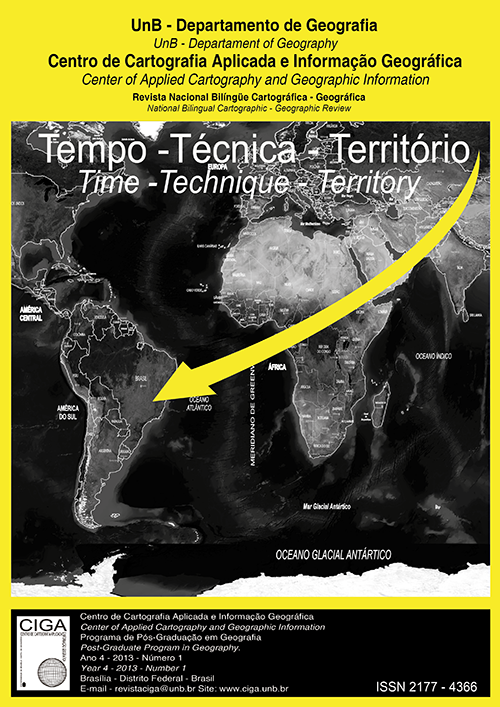O USO DE IMAGENS HIPERESPECTRAIS COM EFEITOS DE REFLECTÂNCIA BIDIRECIONAL NA MELHORIA DA CLASSIFICAÇÃO DE CULTURAS AGRÍCOLAS
DOI:
https://doi.org/10.26512/ciga.v4i1.16316Resumo
O mapeamento preciso de campos agrícolas é um dos principais desafios para monitorar áreas usando sensoriamento remoto. As plantações mudam durante o período de crescimento o que requer o uso de imagens de diferentes épocas para melhor identificação das plantas e consequentemente um alto investimento na aquisição destas imagens em várias datas.Downloads
Referências
ASNER, G. Braswell et al. Ecological research need from multiple remote sensing data. Remote Sensing of Environment (63), 1998 p.155-156.
BEISL, U. Correction of Bidirecional effects in imaging Spectrometer Data, Remote Sensing Series, 37, 2001.
BLACKBURN, G. A. Towards the remote sensing of matorral vegetation physiology: relationships between spectral reflectance, pigment, and biophysical characteristisc semiarid bush land canopies. Remote Sensing of Environment, 70. 1999, p.278-292.
CAMPBELL, J.B. Introduction to Remote Sensing, fourth edition ed., Taylor & Francis, New York, 2006.
CARTER, G. A. Reflectance bands and indices for remote estimation of photosynthesis and stomatal conductance in pine canopies. Remote Sensing of Environment, 63, 1998, P61-72.
CHAMPAGNE, C.et al.Exploiting spectral variation from crop phenology agricultural land use classificationProceedings for SPIE- The international Society for Optical Engineering, 588. 2005, p.1-9.
CLEVERS, J.G.P., KOOISTRA, L. AHS 2005: The 2005 airborne imaging spectroscopy campaign in the Milligerwaaard, The Netherlands, Centre for Geo-Information (CGI) report, Wageningen University, 2005 .
COCHRANE, M. A., Using vegetation reflectance variability for species level classification of hyperespectral data, International Journal of Remote Sensing, 21 (10), 2000, p.2075-2087.
DANAHER, T. et al.Bi-directional Reflectance Distribution Function Approaches to Radiometric Calibration of Landsat ETM+ Imagery, IEE Transactions of Geoscience and Remote Sensing, 6, 2001, p2654-2657.
GIANINETTO, M., LECHI, G. The development of super spectral approaches for the improvement of land cover classification. IEE transactions of Geoscience and Remote Sensing, 42 (11), 2004, p. 2670-2679.
HAZEU G. Land use mapping and monitoring in the Netherlands (LGN 5), paper presented at 2nd EARsel workshop on land use and land cover, Bonn, set, 2006, p28-30.
ITT, C. ENVI user forum Acessado em dezembro de 2007.
KUKKO, A., et al. Use of HRSC-A for sampling bidirectional reflectance, ISPRS Journal of photogrammetry and Remote Sensing, 59 (6) , 2005, p323-341.
LANDGREBE, D. Some fundamentals and methods for hyperespectral image data analysis,Systems and technologies for clinical diagnostics and drug discovery, 2 (3603)6. 1999.
LIESENBERG, V. et al.Variations in reflectance with seasonality and viewing geometry, implications for classification of Brazilian savanna physiognomics with MISR .Terra data, Remote Sensing of Environment, 107, , 2007, p276-286.
LILLESAND, T et al. Remote Sensing and Image Interpretation, 5th edition, John Wiley, New York, EUA, 2004.
PRICE, J. C. Variability of high-resolution crop reflectance spectra, International Journal of Remote Sensing, 13 (14), 1992, p2593-2610.
SANDEMEIER, S., DEERING D.W. Structure Analysis and Classification of Boreal Forests using airborne hyperespectral BRDF data from ASAS, Remote Sensing of Environment, 69,1999.p.281-295.
SU, L. et al. Differentiation of semiarid vegetation types based on multi-angular observation from MIRS and MODIS , International journal of Remote Sensing, 28 (5/6), 2007, p1419-1424.
THENKABAIL, P.S. Optimal hyperespectral narrow bands for discriminating agricultural crops, Remote Sensing Reviews, 20 (4), 2002, p.257-291.
THENKABAIL, P.S.et al. , Accuracy assessment of hyperspectral waveband performance for vegetation analysis applications, Remote Sensing of Environment, 9 (3/4), 2004, p354-376.



